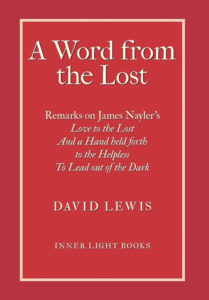A Word from the Lost: Remarks on James Nayler’s Love to the Lost and a Hand Held Forth to the Helpless to Lead Out of the Dark
Reviewed by Brian Drayton
March 1, 2020
 By David Lewis. Inner Light Books, 2019. 276 pages. $35/hardcover; $25/paperback; $12.50/eBook.
By David Lewis. Inner Light Books, 2019. 276 pages. $35/hardcover; $25/paperback; $12.50/eBook.
This is an unusual and thought-provoking book, a series of reflections on an important early Quaker text, driven by the author’s seeking and reflection as a modern Friend troubled by the condition of Quakerism as he knows it: “[I do not think that] British Quakerism has all the answers or voices the ‘correct’ Quaker theology. . . . On the contrary, as my title suggests, we may well be lost.”
A bit of context: James Nayler was one of the leading Friends of the first generation, and in its first decade one of the movement’s most effective and prolific writers (the standard edition of his works occupies four thick volumes). Love to the Lost (1656) is perhaps the most formidable statement of Quaker doctrine before Robert Barclay’s An Apology for the True Christian Divinity. Nayler’s work, written by a husbandman and revolutionary a mere four years after the Children of the Light first began to gather strength, speaks in unscholarly, vigorous language of close engagement with Scriptures but even more with the Spirit that gave them forth. Nayler presents his writing as a declaration of the Word of the Lord, a prophetic work of proclamation. It is urgent, powerful, dense, and sometimes obscure.
David Lewis, an active British Friend, has done a close reading of Nayler’s work, not to do exegesis but to learn from it: what does it say to him as a modern British Friend, and what light does it cast on modern Quakerism as Lewis knows it? The book provides a useful introduction to Nayler and to the times in which Quakerism arose. In addition to the political analysis that is typical of such introductions, Lewis adds information about the economic condition of Britain. This includes the decline or destruction by rising capitalist forces of the agrarian and artisanal society that had been stable and reasonably abundant for the preceding several centuries. These developments intensified income inequality, which drove much of the social unrest of the time. Many readers will not have been aware of the research on the effects of climate change on the landscape and quality of life in the British Isles, and Lewis enriches his scene-setting with some of this information. An appendix provides further details on the political and military events of the mid-century revolutionary period.
The bulk of the book then consists of chapters that each treat a chapter of Nayler’s; 14 out of Nayler’s 25 chapters are addressed. First, the main argument of the chapter is introduced, with substantial quotations and explanatory comments to help the reader get a clearer understanding of the material. Lewis writes: “Several mountain ranges stand between us and Nayler,” including all the cultural developments that have taken place between the 1650s and the twenty-first century. Acutely, he notes: “Modern British Friends probably understand more about Buddhism and Celtic mysticism, for example, than about the theological mix of Reformation Europe.” His notes are intended to enable modern Friends to overcome some of these barriers in order to examine the extent to which “there is a continuity in spirituality between Nayler and twenty-first-century Friends, even though it may not be expressed in the same language.”
Once Lewis has presented Nayler’s material, he then adds a layer of more personal reflections: what does he find hard in each chapter? Challenging? He “stranges” at the idea of Christ being born in us, or as being the head of the church: “I find this a remarkable and disturbing vision of a Christ that physically grows within our bodies. . . . The visual image of the head of God upon the shoulders of a Friend in meeting is striking and brutal.” Elsewhere, he says: “I find redemption the hardest theological concept to understand.” Lewis takes these and other challenges as opportunities for inquiry and reflection on his own attitudes, modern Quaker thought, and Nayler’s intent and experience. He brings in the fruit of his readings of other texts by Nayler and his contemporaries, Friends from then and now, and non-Quaker authorities as well.
In almost all of these chapters, Lewis compares Nayler’s ideas with writings from books of discipline of London Yearly Meeting (later Britain Yearly Meeting) over the past two centuries in order to examine the evolution of ideas over the centuries on such matters as worship, government, and the nature and role of Christ in British Quaker thought. Some of these reflections are quite extensive, such as in the chapter “‘Concerning Perfection’”; others are more perfunctory, but the exercise is a rewarding one to read and to try for oneself.
Finally, there are several chapters on additional topics of interest, including women; Ann Nayler; and the relationship between James Nayler and Martha Simmonds, a Friend who made valued contributions to the publishing of Truth but was also an important player in Nayler’s “fall” in Bristol in 1656. Lewis’s conjectures about Ann’s or Martha’s inward conditions must be speculative at best and not always convincing. As with the whole of this interesting and deeply considered book, however, they repay attention and reflection.


